Introduction
This work presents a description of the research design and approach of the current study. “In the discussion of the selection of a problem suggests valuable criteria: (1) novelty of the problem, (2) investigator’s interest in the problem, (3) practical value of the research to the investigator, (4) worker’s special qualification, (5) availability of the data, (6) cost of investigation, and (7) time required for the investigation,”(Watkins (1994) quoted by Reyes, (2004); Burns and Grove, (2005). Consideration of all these factors lead to the critical elements in undertaking the social research, which is to identify a way of focusing on several elements of the research like statement of the problem, developing a theoretical foundation and embarking on the appropriate research design. “Focus provides the integration of seeming diversity of the elements of the process from the presentation of the problem to the scope of research, conceptual framework, related literature, instrumentation, appropriate statistical methods to be used as well as the design and methodology used,” (Reyes, 2004, p 3).
Denzin and Lincoln (2003) observe that a social researcher can pursue any research design, as far as the chosen design has the ability to enable me accomplish the aim of the current study. Nevertheless, the researcher has to take into account the scope and nature of research topic in choosing the research approach as well as other elements affecting the conduct of the research inquiry. The selected method must correspond with the nature of the inquiry. The current study used quantitative approach of survey and information gathered through secondary research to achieve the aims of the research. The research design and the methodology adopted to conduct the research form part of this work.
Research Approach
Deductive and inductive approaches are the usual research approaches that are used in social science researches. According to Saunders et al. (2009), deductive technique requires the researcher to formulate different hypotheses and engage a research strategy to prove or disprove the hypotheses. Deductive approach starts with the formation of a general idea on the research issue. Based on the idea generated the researcher forms hypotheses, which can be tested using appropriate research techniques and tools to support the general idea generated. If the hypotheses are supported, it implies that the initial idea generated about the research issue is correct. A social research often uses the deductive approach rather than the inductive approach.
In the inductive approach, the researcher starts the process with data collection and once the data is collected, he develops a theory based on the analysis of the data collected earlier. Creswell (2003) observes that the inductive approach investigates research topics, which are relatively noticeable and exciting as well as contentious.
Saunders et al. (2009) identify the goal of inductive approach is to get a better understanding of meaning attached by human beings to events. Inductive approach also provides an in-depth knowledge of the research context. Inductive approach also comprises of the process of data collection for a qualitative study. When the researcher uses inductive approach, there is the likelihood that the researcher can change the research emphasis as the approach encompasses flexible formation that facilitates changes. However, the major concern about inductive approach is that the approach does not possess the requirement of generalization.
Saunders et al. (2009) identify the purpose of research approach as the indication of whether the commitment of “… theory is explicit within the research design”. Mason (2002) states the goal of research approach is “deciding what theory does for your arguments”. The appropriate research approach will help the researcher in choosing the research design, which will facilitate the research process most. This study uses a deductive research approach, since different objectives have been proposed to be achieved prior to engaging a research strategy.
Research Strategy
According to Robson (2002), there are three different research strategies for responding to the various research questions. They are (i) experimental, (ii) survey and (iii) case study strategies. While scientific studies adopt experimental strategies, social science researches prefer survey and case study strategies. The study proposed to adopt a conceptual model as proposed by Yin (2008). Yin (2008) is of the opinion that conceptual models are particularly useful in the collection of information, which is well defined and which can be discussed and analyzed at a later stage. This model enables explaining the facts through theory and the expansion of knowledge through the clarification of the relationship between reality and theory. The researcher considered using the secondary research for collection of the required data to supplement the primary data collected through questionnaire.
Quantitative and Qualitative Approaches
There are two main methods of conducting social researches. They are qualitative method and quantitative method. Quantitative research considers numeric values. Under this method, the study makes use of different statistical analytical methods and processes to achieve the research objectives (Bernard, 2000). Quantitative method is based on empirical data collected for carrying out the research. There are different research tools including survey for collecting primary empirical data for the purposes of quantitative research. Burns & Grove (2005) state quantitative research is “a formal, objective, systematic process in which numerical data is utilized to obtain information about the research question.” Objectivity and reliability embedded in quantitative research makes the researcher feel comfortable and therefore this method becomes a preferred research method. Same findings will result from the study, even when, the same research is conducted by different researchers. Quantitative research has the capability to produce the findings in the form of quantifiable and reliable data, which is a unique strength of this method (Trochim, 2001).
Quantitative methods, which include questionnaire survey and structured interviews, seemed to have been employed widely in conducting the empirical studies. Several contextual factors such as size, structure, technology, environment and culture are among those that have been identified to affect the construction management practices by organizations. Results and conclusions of these studies are usually prescriptive in nature. In general, the quantitative approaches can be characterized as “thin”, “narrow”, but generalisable.
Qualitative method involves the examination of perceptions and opinions of individuals participating in a study. The perceptions are considered from the purview of informants about the issue being studied. Smaller sample size is one of the major limitations of the qualitative method. This leads to poor generalization of the research findings. Qualitative research uses such methods of data collection, where there is no quantitative information involved (Lofland & Lofland, 1984). Qualitative studies concentrate on the quality of information rather than on the quantitative aspects. Considering the merits and demerits of both qualitative and quantitative approaches, it was proposed to adopt quantitative approach to achieve the objectives of this research.
Primary and Secondary Research
There are two sources from which data can be collected to proceed with any social research, which are primary and secondary sources. Primary data is collected for the first time from different information sources using various research tools. On the other hand, secondary data is gathered using other existing sources, where previous researchers have collected the data for purposes other than the current one (Proctor, 2005). For collecting data to be used in the current study, questionnaire survey method was used to collect information from professional engineers working in Omani construction industry using a survey questionnaire. Secondary sources of information include data provided by prior research studies on the same research issue, professional publications, and other resources providing data through Internet. The secondary data helps the researcher to gather large volume of theoretical models and frameworks on the research subject.
Data Collection
Marshall and Rossman (1995) observe that the qualitative study uses information collected from several sources. Information received from these sources help the researcher to report on the results of the research and offer his suggestions. Yin (2008) recognizes various sources such as previous documentations, direct examinations and interviews with samples, which would help in proceeding with qualitative research. In the case of quantitative method, survey method is used as the research instrument for gathering the required information. Boojihawon, (2006) is of the opinion that qualitative research comprises of the ways to discern, examine, compare and contrast and interpret consequential models. Consequentiality is decided by the specific ends to be achieved by the research project.
Empirical Survey
Scott and Usher, (2000) point out that most of the surveys commonly follow positivist epistemology as the research philosophy. The current study uses survey as the research instrument to collect primary data from the target samples. The survey uses an electronic questionnaire for data collection. The questionnaire as the research instrument is the conduit for primary data collection. The electronic survey provides convenience in approaching the samples and in collecting their viewpoints on the research inquiry. According to Yin (2008), surveys are one of the important strategies that can be used in a social research. Surveys are considered as the most popular method of primary data collection from knowledgeable sources of data. Denscombe (1998) states a survey is undertaken “to get a detailed and comprehensive view about the data obtained, which will be used for mapping”. Denscombe (1998) has identified three salient features of survey method.
- Broad and comprehensive coverage
- Data relating to particular point of time when the research is conducted
- Facilitates experimental research
Survey method has become popular because the method is able to express the finding in the form of quantitative or numeric descriptions based on information retrieved from some fraction of the population representing the sample, by the use of simple questions (Creswell, 2003). Surveys enable generalisation of the findings of the surveys, as there is an opportunity for a large population to take part in surveys.
The principal method of data collection for the survey was by a mail questionnaire. The following section discusses the steps and processes involved in constructing and testing the questionnaire, sample selection, data collection and the statistical methods used in this study.
Construction of the Research Instrument
The primary data collection for the current research is undertaken through the distribution of a self-administered questionnaire to the selected samples. Questionnaire represents a document, which comprises of questions designed to retrieve information from the samples suitable for further analysis and reporting. The construction of the questionnaire involved drawing on the previous researches in the area of claims in the construction industry to examine different aspects that are applicable to the current study. Questionnaires form the instrument of choice and part of their research designs for many scholars and academics belonging to different disciplines (Creswell, 2003). Questionnaires are considered as the most fitting research tool to collect systematic and comparable information from a large population and so that the information collected can be analyzed economically (De Witte and van Muijen, 1999).
In view of the smaller sample volume and the simplicity of research questions, the researcher decided not to undertake a pilot testing. The decision not to use a pilot testing was not expected to affect the validity of the findings as the questions contained in the questionnaire were simple and straight forward. Pilot testing is usually resorted to in cases where there is any likely ambiguity in the questions. Because the questions on the causes and impact of claims are not new to the participants, not conducting a pilot testing has not affected the progress of the research. The professional background and experience of the samples also supported the decision to avoid the pilot testing. Moreover, the respondents because of their experience in the industry have been assumed to have considerable knowledge in the topic of study and therefore are assumed to be capable of answering the questions.
Questionnaire
The modified questionnaire, which ultimately became the final one, is shown in Appendix I. The final questionnaire contained two parts. The first part comprised of questions related to demographic information (i.e. employee-related information and personal background). The second part listed out some questions on different aspects of causes, effects and resolution of claims in the construction industry of Oman. A five-point Likert scale was used for the questionnaire. The respondents were asked to indicate the level of importance and the level of applicability of the listed items. A scale of “5” represents an extremely important/highly applicable variable while a “1” is considered not all important/not applicable at all. The variables to be measured were arrived at based on the review of the past studies.
Sample Selection
The researcher has the obligation to specify the target population clearly. Even though there are no defined tenets for sample selection, the researcher has to depend on his reasoning ability and decision-making ability. Target sample has to be specified bearing in mind the goals of the research (McNeill & Chapmanm 2005). In cases where the total group to be studied is little, the researcher can consider including the total group to be covered in the research. When the population to be studied is too large, the person conducting the research can vigilantly choose samples to symbolize the total population. The sample must be selected to symbolize the qualities of the segment from which the sample was selected. Probability or non-probability sampling techniques are used to choose the samples. In probability sampling, all the elements in the group stand the chance to be chosen as samples. For this research, the samples were chosen under random sampling under the category of probability sampling.
First, a list of employees of engineers working with the Ministry of Regional Municipalities and Water Resources as well as some of the private companies and with available demographic details was prepared to select the sample, who could respond to the survey. The HR departments were contacted with a request for the demographic details, based on which the list was prepared. Engineers with professional qualifications and experience who would be able to understand the construction management requirements and practices were selected. An elimination process was undertaken to remove those sample having lesser years of experience with the company. Out of 84 engineers totally screened, 66 of them were identified as capable of answering the survey questions. Questionnaires were sent to 56 employees of whom 48 returned the survey questionnaire duly filled. The responses of four samples could not be considered making the effective response from 44 samples. The response rate was 78.5%. According to Idrus & Newman, (2002), this response rate is considered acceptable in the construction industry.
Validity of the Research
In any social or educational research, the conclusions drawn from the analysis of the findings from the survey data can be accepted to the degree to which they are determined to be valid. The objective of testing the validity is to ensure whether the research has measured the criterion it intended to measure. Tests of validity are also used to estimate the truthfulness of the results of the survey approximately. Normally it is left to the researchers to specify their own definition of the extent of validity. In quantitative research, there are provisions for testing the validity and reliability of the results. It is to be noted that, “to disregard validity is to put the trustworthiness of your work in question and to call into question others confidence in results.” (Tariq, 2009) Validity and reliability are at the root of making a good and bad research report.
Thus, validity is to be construed as an important concept in establishing the credibility of the findings of the research. According to Avis and Freshwater, (2006), validity is an epistemological concept. The application of validity to any research findings depend on the fundamental positions taken about the nature of truth. The representation and the scientific methodology used in conducting the research also contribute and enhance the validity of the findings of a research. This research extends to the examination of the causes, effects and resolution of claims in construction industry in the setting of the Sultanate of Oman. The data and information is gathered from well-informed respondents and therefore the validity of the research findings can be vouched.
For ensuring practical validity of the research findings, it is important that proper sampling method be followed to select the samples for the survey. The samples need to be selected after a careful consideration of the characteristics of the samples and a proper sample size is determined. If there are different groups of samples, it is important that there is a proper description of how individual participants are assigned to the respective groups. For the current research, the samples have been selected after a careful consideration of all relevant aspects and therefore the practical validity of the findings has been ensured.
Summary
This work presented a brief description of the methodology adopted for conducting the current research. Discussion on the quantitative approach and survey method formed part of this work. Construction of the questionnaire and data collection method was also discussed. The next part presents the findings of the survey.
Data Collection and Analysis
This study sought to investigate the causes, effects and resolution of claims in the construction industry in the context of the Sultanate of Oman. The current study examined the construction management practices followed in the Oman construction industry based on a review of the relevant literature. In this context, this part presents the findings from the quantitative survey conducted among 44 engineers working in the Ministry of Regional Municipalities and Water Resources and other private construction companies on their experiences and perceptions of claims in the construction industry of Oman. Survey was conducted by sending the survey instrument of a questionnaire by email, for collecting primary data on their perceptions and experiences about construction management principles and practices in general and more specifically about the claims in the construction industry of Oman. There were different categories of engineers who constituted the respondents to the survey. Questionnaires were sent to 66 employees of whom, 44 of them responded to the questionnaire survey making the response rate of 66.7%.
Findings – Profile of Respondents
Analysis of the profiles of the respondents from the engineers surveyed indicates that majority of the respondents were working for government departments. The respondents represent the engineers who were involved in the construction of public infrastructure projects like dams, roads and other large buildings both in the public and private sector, who had knowledge in the construction management practices of the company. Since the research followed a non-probability sampling technique, the samples do not fulfil any objectives of statistical requirements meeting the standards of prescribed experience in specific construction management areas or belonging to particular category of employment. In addition, the samples were working in different cadres of the government department. Even though there is no balance in the samples chosen in respect of their attributes, the survey has evoked a reasonable response from the respondents to meet the objectives of the study. With more number of employee respondents having professional qualifications and are working in the middle management positions, they are in a position to offer valuable information on the construction management practices in Oman.
The educational qualifications of the employees representing the samples reveal that majority of them are holding professional qualifications, which fact validates the findings of the study, as they would be able to offer better views on the application of construction management principles and practices especially with respect to claims in the industry. It is also interesting to learn that all of the organizations to which the respondents belong had a turnover of more than R.O 10 million and a majority of them have handled individual projects worth between R.O 1 and 10 million, which implies that the projects handled by the samples would have experienced more number of claims to support their responses. The profile of the respondent s becomes important to assess the homogeneity of the samples and their representation of the total population. Based on the information on the profile of the respondent employees, it can be stated that they represent the total population of the construction professionals. Therefore, no sampling bias will arise in the current research. This section describes the findings of the study on the demographic information of the respondents, like age, educational qualification and experience in the industry.
Out of the respondents 30 of them belong to government department (client organization); nine of them were from contracting firms and five from consultancy firms. The distribution of samples is presented in the figure 6.1.
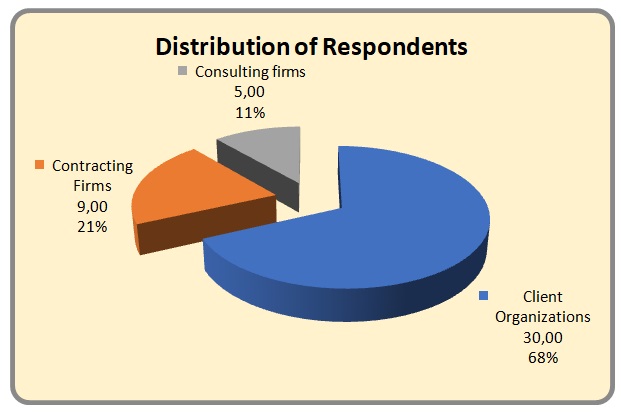
All of the respondents were working in organizations having a turnover of more than R.O 5 million. Sixty two percent of the respondents were in the category of project managers and the remaining were engineers. Figure 6.2 represents the information relating to category of professionals.
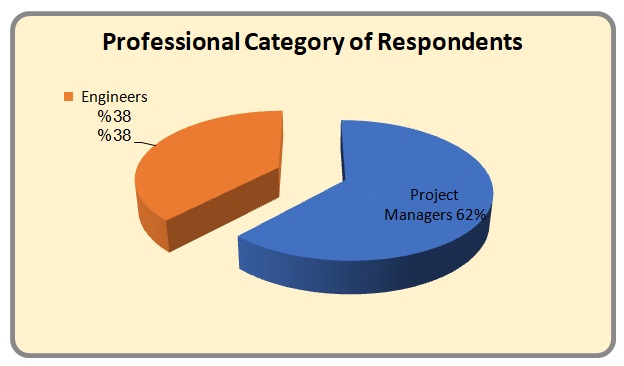
For the question on the length of experience in the construction industry the respondents to the survey replied most of them having experience of between five and fifteen years. The answers to the questions are presented in the figure 6.3. The years of experience of the samples is of relevance, as samples with more years of experience in the construction industry are most likely to have exposure to several instances of claims and disputes and the ways in which the project management handles the claim situations. The fact that most of the samples have between 5 to 15 years experience add strength to the research findings.
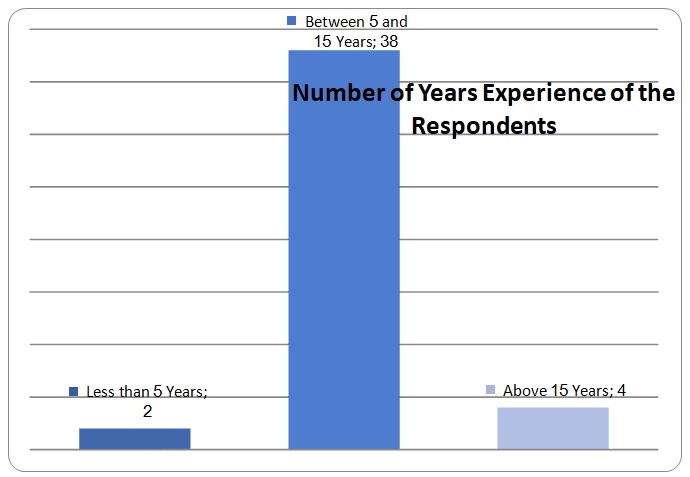
The next question on the education level of education of the employee respondents surveyed for the research. Table 6.1 reveals the education levels.
Table 6.1: Education Level of the Respondents.
The next question on the profile of the respondents was on the highest cost of the projects handled by the respondents. The replies of the samples are presented in figure 6.4.
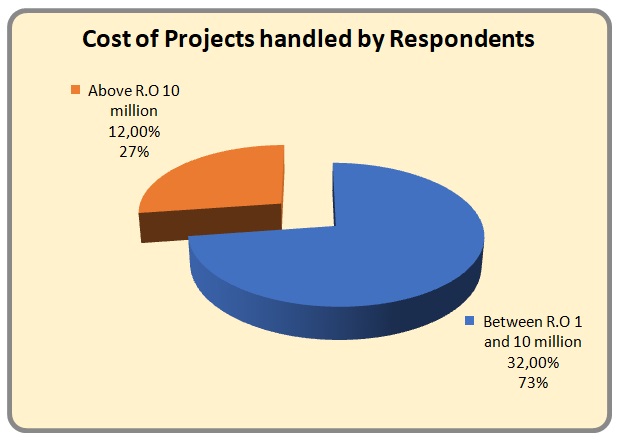
Findings – Claims in Construction Projects
The second part of the questionnaire contained questions on the management practices of the construction industry. The questions were designed in such a way to get the information from the respondents on the different issues based on their experience in the industry and their professional knowledge on the issues concerning causes, effects and resolution of claims in the construction industry of Oman.
General Issues
The first question was on the familiarity of the respondent’s organization with different procurement methods. Majority of the respondents’ organizations had been following the traditional general contracting format followed by design and build format of contracting. Figure 6.5 represents the results.
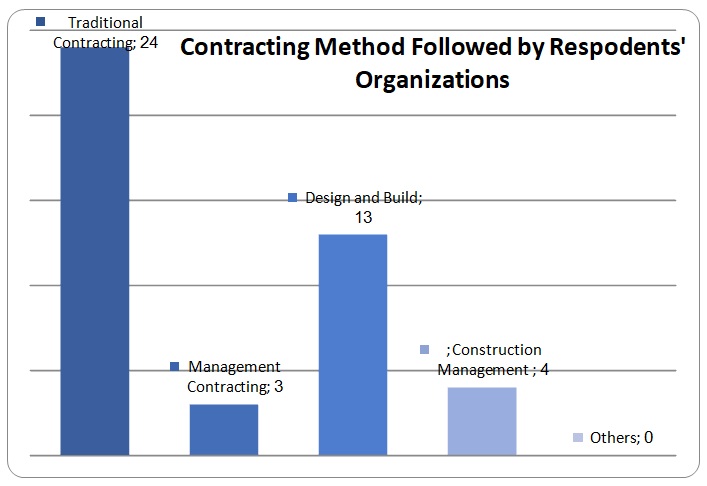
On the question of the most important criteria that the respondents’ organizations considered, while accepting the construction contract the respondents have mentioned the time from inception to finish and clarity of contrat terms as the most important criteria for accepting the contract. The responses given by the samples have been assigned the weight based on their choice and the mean value of the responses have been obtained for finding out the most important factors. The mean values of the responses are represented in the figure 6.6.
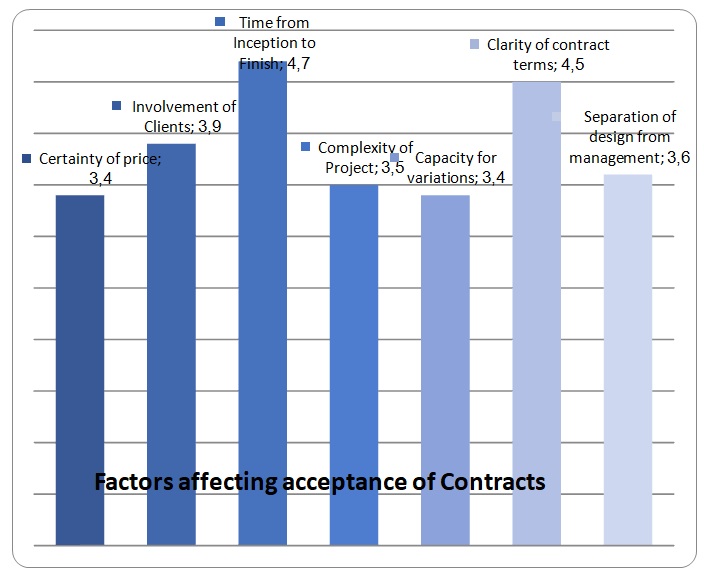
The respondents were asked to identify the common cause of failure of a construction project. The mean values of the responses for this question are indicated in the figure 6.7, which indicaetes that incomplete design and poor supervision are the common causes for the failure of the contracts.
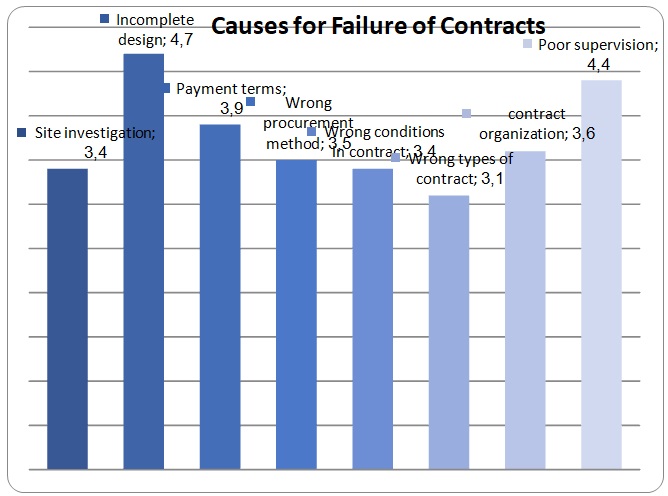
Project Issues in the Context of Oman
The respondents were asked to indicate the project issue which in their opinion is most likely to affect the progress of the construction projects in Oman. The respondents were given six options and asked to rank them in the order of their preference. The responses were provided with weights and the mean values calculated for presentation. The results indicate that delays and cost overruns are the most important project issues in the context of Oman. Figure 6.8 represents the results.
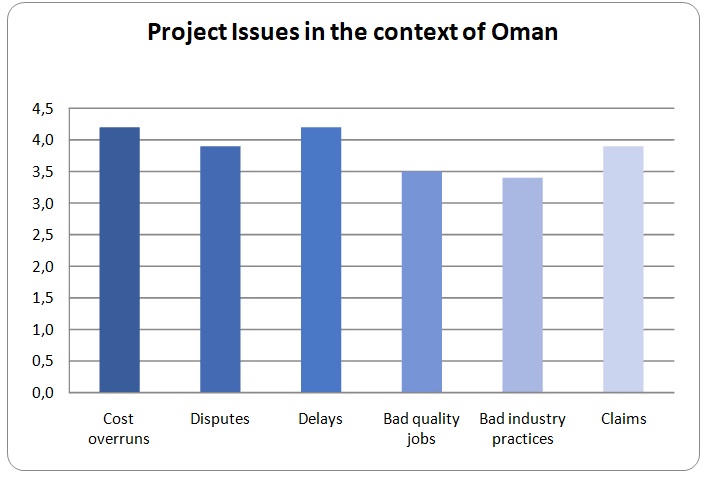
Frequency and Severity of Claims
From a list of circumstances that might lead to claims in the construction project, the respondents were asked to indicate the frequency and severity of different causes of claims in Oman. The reasons and causes of claims were divided into contract-administration based, site-conditions based and information-based claims. The frequency has been defined as Never- where there is no occurrence of claims; occasionally implying claims occurring in one or two projects, frequently implying claims occurring in three to seven projects and constantly denoting the claims occurring in more than seven instances. The severity has been defined to include the positions of no effect, fairly, severe and very severe.
Contract-administration based reasons and causes for claims included late payments, design faults, receiving work orders with errors, delays in execution of jobs and detecting discrepancies between construction documents. The respondents have identified the design faults and delays in execution to occur constantly, while receiving work orders with errors and detecting discrepancies between construction documents to occur frequently. The results are represented in the figure 6.9.
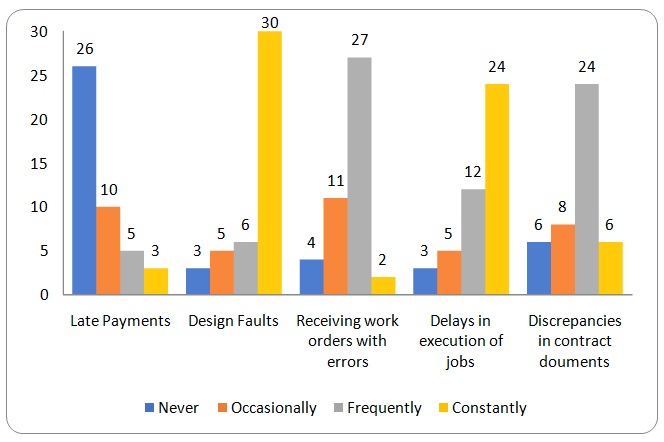
The severity with which the causes affect the construction industry has been identified by the professionals, from their experience in the construction industry. The participants have identified delays in execution of jobs and discrepancies in construction documents to have very severe effect and design faults to have severe impact on the progress of the construction projects in Oman. The results are represented in figure 6.10.
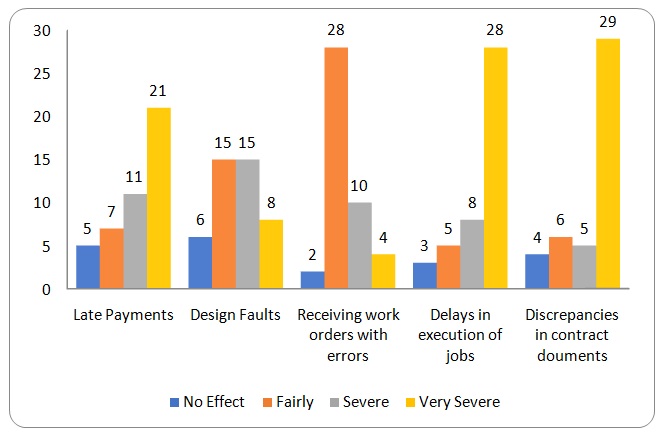
The next question was relating to site-condition based causes resulting in claims in the construction projects in Oman. The respondents were given the options of unforeseen site conditions, delays in handling the site to the contractor, misrepresentation in tender documents about site conditions, unreolved neighborhood issue and delays in obtaining government clearances.
On the question of frequency the respondents reported that unforeseen site conditions and delays in obtaining government clearances were the most important causes leading to claims in the context of the construction industry of Oman. Figure 6.11 represents the results.
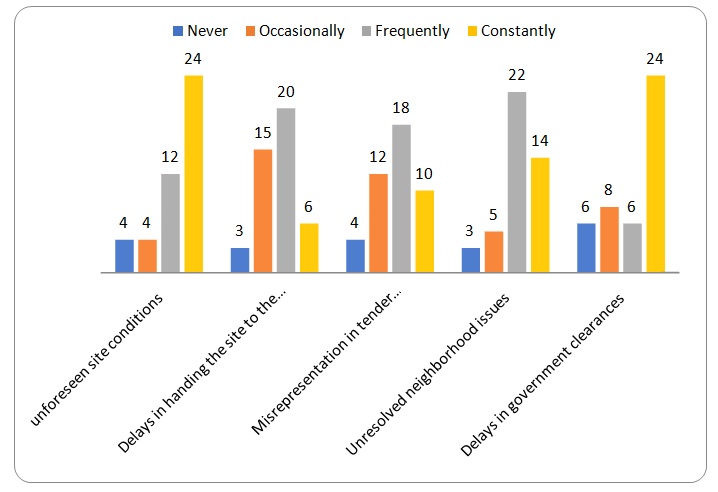
On the question of severity of the site condition based reasons, the respondents have indicated that delays in government approvals and unresolved neighbourhood issues pose serious challenges to the progress of the construction projects in Oman. The responses of the samples are presented in the figure 6.12.
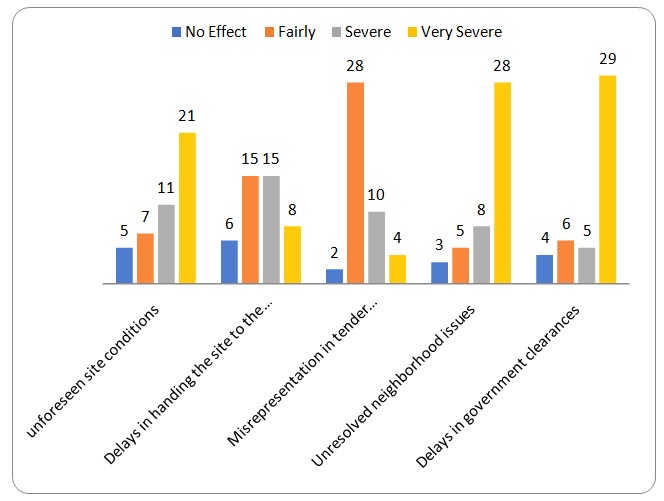
The next question is on the reasons for claims in Omani construction companies because of reasons which are information-based. The respondents have been asked to provide their opinions on the frequency and severity of the reasons and were given the options of differences in bill quantities and executed quantities, dispute over cost of addition or deletion of work, failure to make requests for variation orders in time, failure to submit the bills and progress in time and poor communication with project stakeholders. The respondents have found claims arising in the Omani construction projects mainly because of disputes over cost of addition or deletion of work and failure to make variation requests in time. The responses are presented in the figure 6.13.
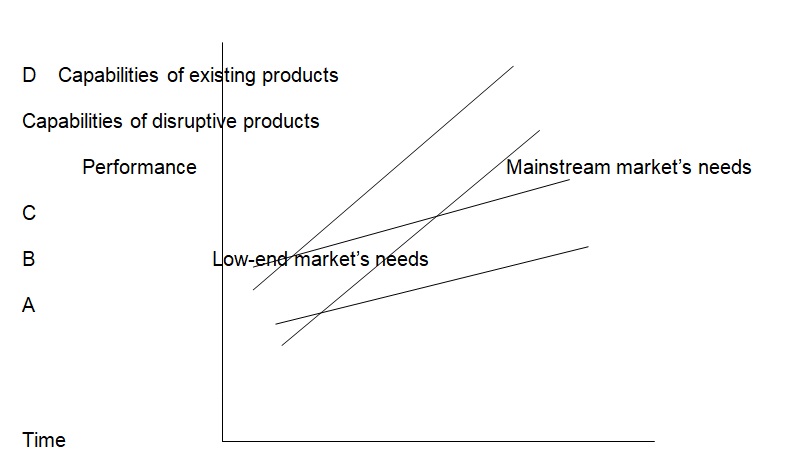
The respondents have expressed the opinion that poor communication with project stakeholders severely affects the progress of construction projects in Oman. Next to this, failure to submit the bills in correct time affects the project progress. Figure 6.14 represents the results.
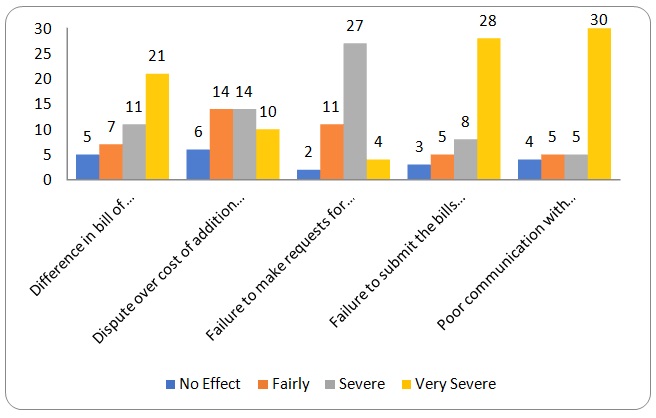
Impact of Claims
The next question was to find the impact of claims issues on the construction projects. The respondents were asked to express their views on different impacts listed in the question paper on the construction project. The questionnaire listed nine different options like, misunderstanding between all the parties, loss of profit to the contractor, loss of profit to the client, failure to maintain the expected quality, time overruns, loss of productivity, loss of reputation of contractor, loss of reputation of the consultant and employers’ reputation at risk. The respondents have indicated that time overruns and loss of productivity have occurred in many construction projects and therefore the impact of claims is mostly felt in the form of loss of productivity. Time overruns have been found to be the next important impact of the claims in terms of frequency. Figure 6.15 represents the responses of the participants.
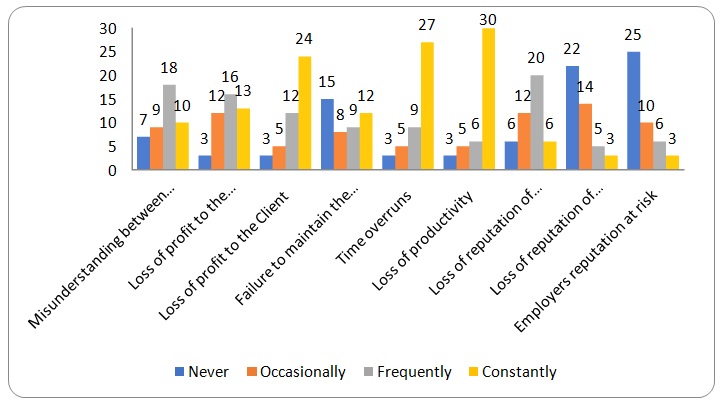
The respondents have identified loss of profit to the client and time overruns as the very severe impact of the claims in construction industry in Oman. The results are represented in figure 6.16.
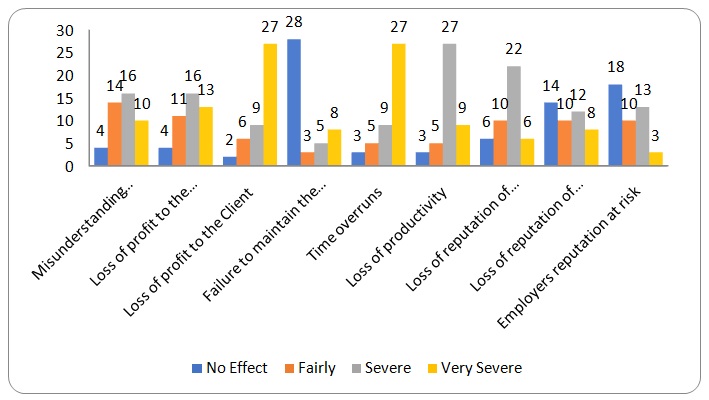
On the question of any other reasons, three of the respondents remarked financial difficulties of the contractors as the main cause for claims in the industry. Five of the respondents remarked the financial difficulties of the clients as the reason for claims. Some of the respondents have added suggestions for best practices in the construction industry in Oman.
Discussion
Construction industry deals with the construction of residential and commercial buildings, educational institutions, factories; infrastructure i.e. bridges highways and utilities. Construction industry significantly contributes to the national economy in both developing and developed countries. “The construction industry is large, volatile, and requires tremendous capital outlays,” (Tumi et al. 2009). It numerously creates job opportunities and plays a vital role by reducing unemployment in the country. The construction industry has complex and diverse nature and fizzy boundaries. The final products of the industry are unique and are produced as result of various activities and inputs by the involvement of different groups and resources.
Every project termed as high profile and of top priority as eventually directly or indirectly, has to generate revenues for the client. However, in most instances claims and disputes are found to be the order of the industry, resulting in financial and reputational loss to the contractor as well as the client. Peculiarity of the characteristics of the industry and the large number of stakeholders lead to ambiguity in dealings resulting in misunderstandings and disputes among contractors, subcontractors and clients. Such misunderstandings of the contract terms and ambiguity in scope of work would result in claims. In many instances changes in designs and consequent variation requests also lead to claims and disputes.
Several other factors cause claims in projects. Factors such as (i) a high number of actors involved in the construction projects, (ii) extreme variations in approaches among the actors involved in the projects, (iii) lack of clarity on the gains arising from the cooperation among the stakeholders and actors, (iv) high level of transaction costs, (v) institutional and social norms, which tend to discourage free flow of information, active collaboration, risk taking behaviour of the participants and signalling of commitment, (vi) absence of regulations for mitigating risks involved and (vii) inadequate funding affect the success of large construction projects greatly. In addition to these factors, lack of coordination among the actors and persons responsible for completion of the project also acts to impede the progress of the projects to large extent.
Many of the factors listed above at one time or other becomes the reason for cost overruns of infrastructure projects causing financial difficulties and other benefit shortfalls to stakeholders, apart from causing delays in completing the projects. Many reasons could be attributed for such delays. Systematic over-optimistic planning in the case of large projects as compared to smaller projects is one of the main reasons. The inaccurate planning leads to erroneous errors in time forecasts.
This research sought to explore the areas of causes, effects and resolutions of claims in the construction industry of Oman. In addition to a detailed review of the literature available on the topic, a questionnaire survey was initiated to substantiate the findings of the research. The results of the survey formed part of the previous sections of this part.
The first issue dealt with by the survey was the type of contracting used by most of the construction firms in Oman. Type of procurement method adopted for a construction project affects the involvement and participation of different stakeholders during the design process. Different procurement methods follow different communication protocols and thereby affect the coordination among the project participants. Most of the construction companies in the country have been following the traditional method of contracting where there is likely to be more involvement of the client in the progress of the project. In this case the client is involved in the design stage of the project and therefore he would be able to make his instructions clear to all concerned. This might reduce the chances of the owner requesting for variations at a later stage. On the other hand, design and build contracts are complex in nature offering scope more change requests from the client. This is because in the case of design and build contracts, the involvement of the owner in the design phase might be less, resulting in misunderstanding on the client’s requirements.
Consequently, there is likely to be more instances where the client would like to change the design to meet his requirements. Changes might be requested by the client after physically reviewing the progress of any particular part of the construction, which might not be up to the expectation of the client. Such a situation will also lead to claims. Even though buildings are three dimensional, traditionally the designs have been created using two dimensional drawings. This implies that the project teams and construction staff, who are involved in the project execution have to visualize the designs from a three dimensional perceptions, which requires perfect coordination among the project members. Although the design team can identify issues with the constructability of the design, it is likely that many of the design issues may go unnoticed if there is no coordination. These design issues may become apparent and might lead to cost and time escalations. Constructability is an important objective for ensuing smooth flow of construction projects. CAD models will help identification of issues with the constructability of a design and consequently reduce the number of claims on account of ambiguity resulting from the contracting method followed in the project.
The parties to a construction contract especially the contractor has to consider a number of factors before accepting the contract. The survey asked the opinion of the respondents on the most important factor that their organization considers while accepting a contract. The samples identified the time and clarity of contract terms as the most important factors. In any construction project the terms execution and planning have different scopes and are to be considered individually. Planning involves the process of drawing up the programs, preparing the schedule of activities and organizing the required resources to complete the project. Planning is only a general term to describe these processes. The objective of undertaking planning in the context of a construction project is to ensure that all the activities, which are required for the completion of the project, are arranged in the required sequence. By careful planning the project management can ensure that the resources required have been organized in an economical and acceptable way. Preject scheduling differently to include “a set of sequenced construction activities.” A project plan differs from a schedule in that project plan exhibits the activities connected with a project and their logic relationship.
A schedule on the other hand contains temporal information, which defines the duration of the project. Successful delivery and execution of the project is determined by well-structured macro planning of the project. Thus, project scheduling becomes an integral part of project planning. Because project scheduling places all the project tasks in a logical sequence, it is essential that all the project stakeholders extend their cooperation during the planning and scheduling phase. A typical project schedule contains the duration of individual tasks and their start and end dates, the interdependency of tasks and the type of dependency. Proper scheduling therefore requires the coordination of all project participants to ensure they highlight the potential issues connected with the individual tasks. While scheduling it is essential that resources required completing the tasks are identified. The availability and adequacy of the resources need to be considered in conjunction with the project scheduling. The resources required for completing a construction project and the structuring of various tasks involved in the project depends largely on the duration of the schedule. The identification of the required resources and their availability requires the coordination of all project stakeholders. These facts go to prove that the time is the most important factor in accepting a project and when the project management is able to make a precise estimation of the project schedule, it must be possible to avoid several situations of claims and disputes.
The next issue dealt with by the survey was the common cause of failure of construction projects. The respondents to the survey have identified that incomplete design and poor supervision are the most important causes for failures in construction projects. The clients in the construction industry do not prefer to entertain any claims, the reason being the employer may have to settle to the contractor amounts exceeding the originally budgeted cost. However, because of its complexity, construction industry often makes different parties face the situation of claims, whether such claims are justified or not. Claims which are in accordance with the terms of the contract are justified and are payable by the party in default. On the other hand those claims which are made and which do not conform to the express provisions of the contract, becomes unjustified and often they lead to disputes among the parties. In the case of justified claims, parties will not have any points to argue about as most of the construction agreements are based on well-drafted agreements defining the roles and responsibilities of each party to the agreement.
Justified and proper claims entitle the party claiming the right to get reimbursement of the direct loss or expense incurred by him additionally to meet with the construction requirements. Changes in designs as requested by the clients or architects or consultants on behalf of the client present opportunities for genuine claims by the contractors and the client or owner is bound to settle such claims being justified ones. In many instances of design and build contracts as being practiced in Oman, the owner because of his lack of technical knowledge or because he does not involve him in the construction process raises number of change requests at a later stage of the construction, which often justified claims from the contractors. Because of clauses in respect of variations included in the construction agreements, these claims become unavoidable and are to be settled by the owner (Scott, 1993; Scott and Billing, 1990). The employer or other parties are expected to take responsibility for such design changes and consequent claims under the terms of the contract.
The main objective of the study is to ascertain the core issues affecting the progress of construction projects in Oman and consequently leading to claims. The survey results indicate the delays and cost overruns are the major issues affecting the construction projects in Oman. Generally, a number of factors are responsible for disrupting the progress of the construction projects. Literature through a large volume of studies has observed that disputes over the durations of contract as one of the major factors that result in disputes among the parties. One of the earlier studies by Chan and Kumaraswamy (1997) found that delays that result in elongated contract period over the originally accepted date of completion, is one of the frequent causes for disputes and claims among the parties.
Such delays normally lead to the payment of liquidated damages by the contractor. In many instances the contractor may request for and the owner may be inclined to allot additional time for completing the contract to the satisfaction of the client. However, the quantum of liquidated damages or the amount of additional time that the owner is willing to grant is a potential source of dispute. In addition to the cost and time overruns the review of the literature has indicated that workday charges as another common issue, which may give rise to disputes among the parties. In the disputes relating to the workday charges, the central cause of dispute will be to decide whether to include a workday in the contract time so that the party bearing the cost of workday is determined (Chester & Hendrickson, 2005; Davies, 1989).
Delays are categorized as excusable and inexcusable under the standard construction contracts. The other category of delays is compensable delays. Excusable delays entitle the contractor the right to claim compensation from the owner (Alkass et al. 2005). The excusable delays occur because of changes requested by the client. In some instances the contractor will be entitled for extra time on account of unforeseen weather conditions. However, the delays occurring in the context of Oman, must be more excusable delays as according to the survey findings, there are number of changes in designs requested by the owners, which offer the contractor to claim direct cost and expenses from the owner. Because design problems are one of the usual sources of excusable delays, the contractors of large construction projects in Oman witness more claims from the contractors. However, in Oman there are occasions for inexcusable delays also, because the contractors’ own makings lead to inexcusable delays. Disputes may also arise because of the inability to determine whether a delay is excusable or inexcusable and consequently to determine the responsibility for the expenses and losses arising out of the delays.
The survey studied the reasons and causes of claims based on contract-administration based, site-conditions based and information-based factors. In this context, the respondents have identified design faults and delay in execution to occur constantly in the construction projects in Oman.
We observed from the review of the literature that a design that is flawed cannot meet the goals of the employer. Apart from the inability to meet the project goals, the design faults are most likely to affect the project schedules and result in cost and time overruns. From the review of the literature it is also learnt that when a contractor is confronted with a design that is ambiguous, the sequence of activities in the construction project is most likely to get disturbed (Turner and Turner 1999). Inconsistencies in designs will hinder the speedy progress of the construction project. In the instances of both ambiguity and inconsistency in the designs, it becomes the responsibility of the contractor to clarify the design aspects. If the contractor has to wait for the clarifications and his waiting costs time and cost overruns, he has to be compensated by the owner of the project concerned.
It must be noted that the contractor may have to incur additional costs as he has to keep his resources remain idle, until such time the design issues are clarified. In case where the discrepancies in the designs are discovered after the commencement of the project, the necessary rework will result in the need for additional cost and time. Literature points out that 40% of the loss and expenses claims were on account of faulty designs (Diekman, 1985). Therefore, it can be stated that the findings of the research are in agreement with the theoretical finding. The reflections on claims due to faulty designs reveal that the seeds of delay leading to disputes and disagreements, which eventually culminate into claims, are sown, even before the commencement of the construction project activities. This makes it important that the contractor must check the design from all aspects before the contract is commenced so that he can save considerable time and money that would be wasted in waiting for the clarifications from the design team.
The next part of the question required the participants to indicate the severity of the contract-administration based causes on the progress of the project. The respondents to the survey have indicated that delays in execution of jobs and discrepancies in the contract documents, as contract administration based claims have severe impact on the progress of the projects.
On the site condition-based causes for claims, the respondents have identified that unforeseen site conditions and delay in getting government clearances are the major causes for delay and claims. Delays in government approvals and unresolved neighbourhood issues as site-condition based issues have been found to delay the progress of construction projects largely. On information based causes the respondents have identified that claims arising in the Omani construction projects mainly because of disputes over cost of addition or deletion of work and failure to make variation requests in time.
Factors or causes of delays are not cognate at every project but these vary from project to project according to the nature, location and complexity. Delays in the construction industry are common and one of the most important issues. Delays in completion of the projects cause financial losses to the project owner. Because of the financial losses incurred by the project, the project owner may find it difficult to settle the payments to the suppliers as well as wages and salaries to the project team members. Consequent to the liquidity issues, the delayed completion of the project affects the economy of the country.
No construction project gets completed within the allotted time. Most of the time construction schedules have been revised due to various delay factors. Completing projects on time is an indicator of efficiency, but the construction process is subject to many variables and unpredictable factors, which result from various sources (Assaf & Al-Hejji, 2006).
Project delays result from the poor performance of parties connected with the project. For example, delay in supply of materials by the suppliers will lead to delay. Similarly non-availability of resources like men and materials at the required time will also impede the progress of the project. Environmental conditions affect the progress of the project and lead to delays in the completion. Above all, lack of coordination among project stakeholders including contractors is the main cause of delays in completing the projects.
Delays can arise from contractor’s firms or because of any other elements that has an association with the construction project. Globalization, research and use of IT in production industry have reduced the risk of delay but construction industry due its volatile nature still suffers delays.
These delays are normally related to the project planning, owner’s decision making (variations), manpower, supervision, late issue of drawing, slow decision making by government authorities and lack of coordination. In recent years due to global recession, many projects were abandoned or delayed due to lack of finance. Today’s construction project has become a very complex, high-risk, and multiparty endeavor. Construction projects are composed of many interrelated elements of labor, cost, material, schedule, other resources, and lot of coordination, making it difficult to define, which factors were the main causes for delay on a given project. Identifying the main causes of delay in large construction projects is very difficult and often initiates disputes about responsibility for the delay.
The complexity of multidisciplinary construction projects makes it difficult for the planners and contract administrator to identify the real cause of delay, its magnitude of effect and the party liable for such delay, especially in case of major infrastructure projects as lot of coordination is required among different stakeholders e.g. client, contractors and different local authorities. Contractors are required to have fast track coordination with clients and local authorities to have timely approvals for different issues related to infrastructure works e.g. power supply works, sewerage network connections and other existing services coming under or within the infrastructure. Contractors/consultants have to get approvals first for the design and construction and then final testing or taking over which is related to different authorities, all this required proper coordination to avoid delays. Sometimes these are existing services and networks, in that case, contractors, need to start their coordination with local authorities, right from the beginning of project. These are the observations made out of the review of the relevant literature on the causes of claims in construction industry.
On the information based causes, the participants to the survey have expressed the opinion that poor communication with project stakeholders severely affects the progress of construction projects in Oman. Poor communication channels in project normally lead to lack of coordination among the project teams and member and participating firms. When it is possible to establish proper communication channels among different project teams, many of the problems that are likely to emerge during different phases of construction can be resolved without the involvement of the project owner.
In case, where the project coordination of a large infrastructure project is left to a foreign design and architectural firm, the feedbacks of the local contractors may not easily reach the architect and the engineers in time. This will lead to coordination problems arising within the design team and those with contractors. Construction activity especially large infrastructure projects depend on the coordination of the activities of different project team members. Strong relationships between the design team members and other project participants have large influence on the timely completion of the project with the expected quality. These relationships are normally established at the early stages of the project initiation and clear and cohesive communication among the project team members act to nurture the relationships so established. However, ineffective communication and language barriers may impede proper communication leading to project delays.
It is essential that in managing a large infrastructure project, the architects need to visit the sites and attend site meetings periodically to assess the progress of the project and to remove the deficiencies in the progress of the project. They need to familiarize themselves with the progress and problems in project construction. In some instances, where there are foreign firms are involved in the design phase of the project, there might be considerable waste of time and cost in the travelling of the project executives. Lot of information is exchanged between the project participants and distance may become an impediment to the exchange of the required information causing coordination issues.
Language becomes another issue, in projects where the services of foreign firms are employed. It may so happen that the project participants misunderstand other’s viewpoints because of language barriers. Thus factors of long distance, insufficient communication technique and language hinder the normal communication between the project participants leading to delays in completing the project. Successful coordination is at the root of successful collaboration in construction projects. In construction project, it is important that the work demands right equipment carrying proper materials be available within a short period. Therefore, good communication and coordination are essential elements in improving project performance.
Better coordination has become one of the essential requirements of success in today’s large infrastructure projects, which involve multiple stakeholders. Because the objectives of each of the stakeholders are different it is necessary to have a partnering approach, which will result in better coordination among project participants. The consultant is expected to work closely with the contractor for eliminating any obstacles in the progress of construction and solve the problems, which might hinder the progress of the project. The consultant has the obligation to comment on the methods of wok suggested by the contractor and offer suitable alternatives to improve the progress of construction. In fact, offering suggestions for improvement is considered as one of the criterion for measuring the consultant’s performance (Ng and Chow, 2004). Therefore, success of any construction project depends largely on the effective communication between the consultant and the contractors, which will ensure smooth flow of work within the construction project. If there is a lack in the communication, it might have a repercussion on the progress of the project, leading to delays and claims.
Literature on construction management has identified the need for understanding the complexity in construction projects. Because complexity involves uncertainties and interdependencies, need for coordination arises to remove inefficiencies in operations (Dubois and Gadde, 2002). Better coordination is required not only with the internal project team members but also with external agencies as well. Lack of coordination is most likely to result in duplicity of work causing delays, eventually culminating claims. Similarly lack of coordination with external agencies will lead to lack of synchronization of different activities resulting in cost overruns. Lack of relevant information flow among project stakeholders may result in frequent instances of rework in different project works, reiterating the need for close coordination in construction projects. The coordination process in a construction project depends on the techniques chosen to manage dependencies among the several tasks and resources involved in the project activity.
The final survey question was to find the impact of claims on construction industry. The respondents have indicated that time overruns and loss of productivity have occurred in many construction projects and therefore the impact of claims is mostly felt in the form of loss of productivity.
Conclusion and Recommendations
The current research has been undertaken to examine the causes, effects and resolution of claims in the construction industry of the Sultanate of Oman. The research engaged a quantitative survey among construction professionals working in the public and private sector organization in the construction industry. Survey was conducted with construction professionals, who were working on various construction projects in Oman, using a questionnaire as the survey instrument. Apart from the quantitative survey, the research made extensive revenue of the relevant literature to add to the existing knowledge on claims in construction projects in general, project delays and the impact of claims on the progress of the project.
Research Objectives
The research sought to achieve different objectives. The first objective was to identify the types and circumstances necessitating or prompting claims on public projects in the Sultanate of Oman. This objective was achieved by the extensive literature review undertaken as a part of research and the findings from the survey. The research identified several causes contributing to claims and improper designs were identified to be the most important cause leading to claims. The second objective was to investigate, examine and analyze all negative and positive claim issues from the point of view of clients, consultants, and contractors. The review of the literature provided extended knowledge on the claims issues in the context of construction projects. The third objective was to survey the impacts of such claims from the stakeholder’s perspective. This was achieved by selecting the samples from the construction professionals representing various stakeholders in Oman. The research used the survey instrument of questionnaire retrieved the data and information from the stakeholders on claims and their impacts. The fourth objective was to make recommendations for resolving the major claims issues. Based on the responses of the participants the research has made several recommendations, which form part of the next section.
Research Summary
The review of literature undertaken as a part of the research provided deep insight in to the claims in construction projects, their causes and impacts on the progress of the project. The survey conducted among the construction professionals contained questions covering the causes of claims in the context of Oman construction industry. The survey covered the frequency of the causes for the claims and severity of the causes in affecting the progress of construction projects. The questionnaire presented several options on the questions for the respondents to choose based on their educational background and experience in the construction industry. Based on the survey findings, the research concludes that incomplete designs and poor supervision are the common causes for the failure of construction projects in Oman. The research also concludes that time for the completion of the contract and clarity of contract terms are the important criteria for the clients to accept construction projects in Oman.
Research Findings
The study finds that faulty designs have been one of the major causes for delays, which is contract administration based contributing to claims in construction projects. In respect of causes, which are site-conditions based, unforeseen site conditions have been found to be one of the important cause for the claims in the Omani construction industry. The study also found that in respect of information-based claims, disputes over cost of addition or deletion of work and failure to make variation requests in time are the main factors giving rise to claims. The survey also solicited the opinions of the respondents on the severity of the claims because of various causes under the three different categories. On the contract administration based claims the respondents have identified delays in execution of jobs and discrepancies in contract documents to have very severe impact on the progress of the projects. In the case of site condition based causes, delays in government approvals and unresolved neighbourhood issues to have very severe impact on the progress of the projects. In respect of causes which are information based, the research reports that poor communication with project stakeholders to have a serious impact on the project progress. The research has found that loss of productivity and time overruns as the serious impacts of claims in the case construction projects in Oman.
Conclusion
Based on the review of the literature and the survey conducted as a part of the study, the current research concludes that incomplete design and poor supervision are the common causes for the failure of the construction projects in Oman. The survey results report that the time from inception to finish and clarity of contract terms as the most important criteria for accepting the contract. The research found that time overruns and loss of productivity as the impact of claims that is mostly felt in the construction industry of Oman. Time overruns have been found to be the next important impact of the claims in terms of frequency. Implications for the owners, consultants and contractors and few recommendations for further research forms part of the next section.
Recommendations
The findings from the current research have large implications for project management, owners, contractors working on large construction projects and the consultants.
Based on the review of the literature and the survey, the study suggests that the contractor should check all the contract documents to check the design information and the contract documents and ensure the accuracy thereof. This will go a long way in eliminating causes for claims. In Oman the possibilities for discrepancies in the contract documents are more and therefore this becomes one of the important areas for the contractor to focus. Wherever possible, the contractor must get the written instructions from the client or consultant for carrying out any amendments to the original design. This will reduce the chances for disputes and claims at the later stage of the contract. Project managers working on behalf of the contractors of large construction projects must ensure that they involve the clients in all project meetings especially when the design for the construction is being discussed. Even though the client may not have the required technical knowledge he must be explained all the design features so that he knows what to expect from the construction. This study suggests the use of CAD systems wherever possible to avoid ambiguity in designs.
The clients are in a better position to avoid the chances for potential claims in construction projects. By making their expectations explicitly and clearly known to all concerned the clients can avoid variations and resultant claims. Because faulty or incomplete designs are the major causes for claims the owners must ensure that they go through the designs either on their own (if they possess the required technical knowledge) or with the help of a consultant and confirm that the designs meet his expectations and requirements. Avoidance of frequent variation requests during the progress of the project will reduce the chances of claims in the construction projects. Wherever possible the clients must not insist on the construction to be started before the design is completed.
On his part the consultant will be able to ensure a smooth flow of the construction project. For instance the current research finds that the information-based cause of failure to make variation requests in time is one of the important causes for claims in construction projects in the context of Oman. By helping the variation requests on time, the consultant can ensure smooth flow of the project. The consultant can also play a major role in avoiding claims because of late payments by owners, by ensuring that the bills of the contractors are passed in time without delay.
Further Research
Each construction project varies in scope and nature and with the result is likely to face different challenges of completion. The nature of issues leading to claims and resultant delays may be different. The social and political conditions prevailing in Oman are different from the same in any other geographical location. Therefore it would be advisable to conduct a study which compares the performance of large construction projects in two different countries from a claims perspective. An empirical study on the financial impact on the infrastructure project would add strength to the findings.
References
Alkass, S., Mazerolie, M., Tribaldos, E. and Harris, F. (2005). Computer aided construction delay analysis and claims. Construction Management and Economics, 13(4), 335-52.
Assaf SA, Al-Hejji S. (2006). Causes of delay in large construction projects. Int J Project Management, 24(4):349–57.
Avis, M. and Freshwater, D. (2006), Evidence for practice, epistemology, and critical reflection. Nursing Philosophy, 7: 216–224
Bernard R H, (2000), Social Research Methods, London: Sage
Boojihawon, D.K., (2006), International entrepreneurship strategy and managing network dynamics: SMEs in the UK advertising sector In: Fai, Felicia M. and Morgan, Eleanor J. eds. Managerial issues in international business Academy of international business. New York, NY, USA: Palgrave Macmillan.
Burns, N and Grove. K (2005). The practice of nursing research: Conduct, critique and utilization (5th ed.). Philadelphia: Saunders.
Chan DWM, Kumaraswamy MM. (1997). A comparative study of causes of time overruns in Hong Kong construction projects. Int J Project Management, 15(1):55–63.
Chester, M. and Hendrickson, C. (2005). Cost Impacts, Scheduling Impacts, and the Claims Process During Construction. Journal of Construction Engineering and Management, 131(1), pp. 102- 107, 2005.
Creswell, J. (2003). Research Design: Quantitative & Qualitative Approaches, Sage Publications, Thousand Oaks, CA.
Davies, C. M. (1989). Avoiding Claims: Practical Guide for the Construction Industry. Great Britain: St. Edmundsbury Press Ltd.
Denscombe, M. (1998). The Good Research Guide. Buckingham: Open University Press.
Denzin, N K and Lincoln. Y S (2003). Strategies of qualitative inquiry. Thousand Oaks CA: Sage Publications.
DeWitte, K and VanMuijen. J J (1999). “Organizational Culture,” European Journal of Work and Organizational Psychology 8.4: 497-502.
Diekmann, J. E., and Nelson, M. C. (1985). ‘Construction claims: Frequency and severity. Journal of Construction Engineering and Management. 111 (1), 74–81.
Dubois, A., Gadde, L-E,(2001), The Construction Industry as a Loosely Coupled System – Implications for productivity and innovativity, Paper for the 17th IMP Conference, September 2001, Oslo, Norway
Idrus, A.B. & Newman, J.B. (2002), Construction Related Factors Influencing Choice of Concrete Floor Systems, Construction Management and Economics, 20, 13-19
Lofland, J., & Lofland, L. H., (1984), Analyzing social settings Belmont, CA: Wadsworth Publishing Company, Inc.
Marshall, C & Rossman, G. B., (1985), Designing qualitative research (2nd Ed.) Newbury Park, CA: Sage.
Mason, J., (2002), Qualitative Researching (2nd ed.). London: Sage Publications.
McNeill, P, and S Chapman (2005), Research Methods. Third edition. London: Routledge.
Ng. S.T and Chow, L. (2004). Evaluating Engineering Consultants’ General Capabilities during the Pre-selection Process – A Hong Kong Study. Engineering, Construction and Architectural Management, 11 (3) pp 150-158
Proctor, T, (2005), Essentials of Marketing Research London FT Prentice Hall.
Reyes, M. (2004), Social Research; A Deductive Approach. USA: Rex Bookstore Inc, 2004.
Robson, C. (2002) Real World Research, 2nd ed., Oxford: Blackwell.
Saunders, M, P Lewis and A Thornhill. (2009), Research Methods for Business Students. Harlow: Prentice Hall.
Scott, S.(1993),’Dealing with delay claims: a survey’, International Journal of Project Management, 11 (3), pp 143 – 153.
Scott, B. & Billing, B., (1990). Negotiation Skills in Engineering and Construction. London: Thomas Telford Ltd.
Scott, D. and Usher R., (2000), Researching Education Data, Methods and Theory in Educational Enquiry London: Continuum.
Tariq, (2009), Validity in Research Design, Web.
Trochim, W., (2001). The Research Methods Knowledge Base, Second Edition.
Cincinnati, OH: Atomic Dog Publishing, 2001.
Turner, D. & Turner, A., (1999). Building Contract Claims and Disputes. 2nd ed. Essex: Addison Wesley Longman Limited.
Watkins, J M. (1994), A Post Modern Critical Theory of Research: Knowledge and Policy. London: Falmer.
Yin, R. (2008) Case Study Research: Design and Methods. Beverly Hills CA: Sage Publishing.
